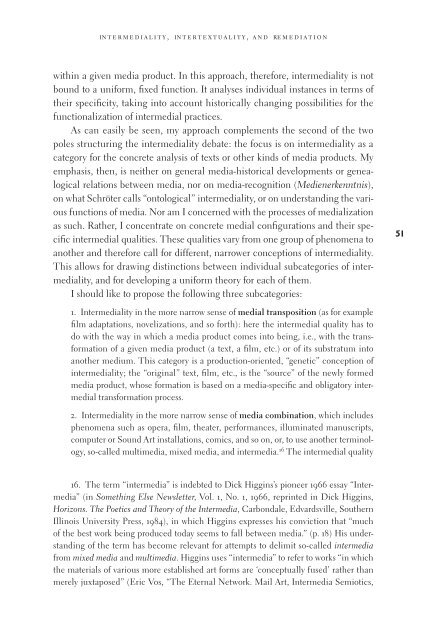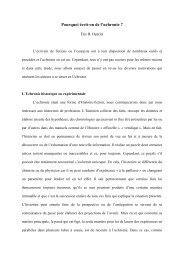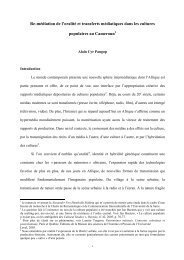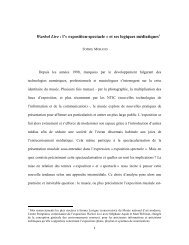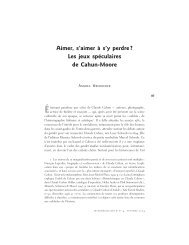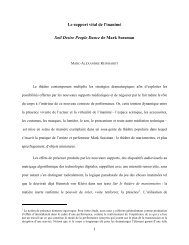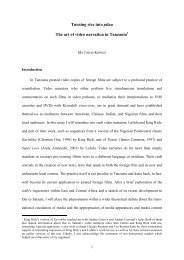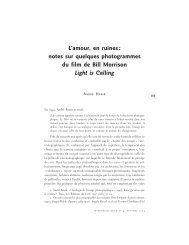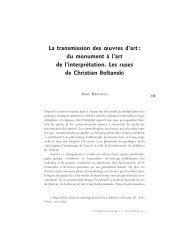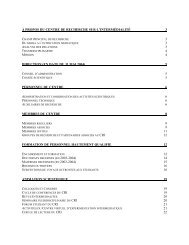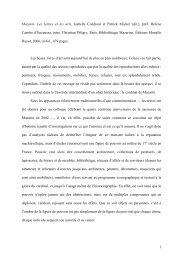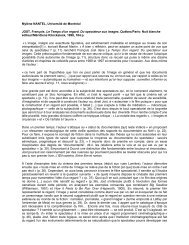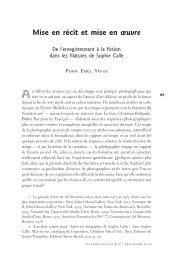Intermediality - Centre de recherche sur l'intermédialité (CRI ...
Intermediality - Centre de recherche sur l'intermédialité (CRI ...
Intermediality - Centre de recherche sur l'intermédialité (CRI ...
Create successful ePaper yourself
Turn your PDF publications into a flip-book with our unique Google optimized e-Paper software.
intermediality, intertextuality, and remediation<br />
within a given media product. In this approach, therefore, intermediality is not<br />
bound to a uniform, fi xed function. It analyses individual instances in terms of<br />
their specifi city, taking into account historically changing possibilities for the<br />
functionalization of intermedial practices.<br />
As can easily be seen, my approach complements the second of the two<br />
poles structuring the intermediality <strong>de</strong>bate: the focus is on intermediality as a<br />
category for the concrete analysis of texts or other kinds of media products. My<br />
emphasis, then, is neither on general media-historical <strong>de</strong>velopments or genealogical<br />
relations between media, nor on media-recognition (Medienerkenntnis),<br />
on what Schröter calls “ontological” intermediality, or on un<strong>de</strong>rstanding the various<br />
functions of media. Nor am I concerned with the processes of medialization<br />
as such. Rather, I concentrate on concrete medial confi gurations and their specifi<br />
c intermedial qualities. These qualities vary from one group of phenomena to<br />
another and therefore call for different, narrower conceptions of intermediality.<br />
This allows for drawing distinctions between individual subcategories of intermediality,<br />
and for <strong>de</strong>veloping a uniform theory for each of them.<br />
I should like to propose the following three subcategories:<br />
1. <strong>Intermediality</strong> in the more narrow sense of medial transposition (as for example<br />
fi lm adaptations, novelizations, and so forth): here the intermedial quality has to<br />
do with the way in which a media product comes into being, i.e., with the transformation<br />
of a given media product (a text, a fi lm, etc.) or of its substratum into<br />
another medium. This category is a production-oriented, “genetic” conception of<br />
intermediality; the “original” text, fi lm, etc., is the “source” of the newly formed<br />
media product, whose formation is based on a media-specifi c and obligatory intermedial<br />
transformation process.<br />
2. <strong>Intermediality</strong> in the more narrow sense of media combination, which inclu<strong>de</strong>s<br />
phenomena such as opera, fi lm, theater, performances, illuminated manuscripts,<br />
computer or Sound Art installations, comics, and so on, or, to use another terminology,<br />
so-called multimedia, mixed media, and intermedia. 16 The intermedial quality<br />
16. The term “intermedia” is in<strong>de</strong>bted to Dick Higgins’s pioneer 1966 essay “Intermedia”<br />
(in Something Else Newsletter, Vol. 1, No. 1, 1966, reprinted in Dick Higgins,<br />
Horizons. The Poetics and Theory of the Intermedia, Carbondale, Edvardsville, Southern<br />
Illinois University Press, 1984), in which Higgins expresses his conviction that “much<br />
of the best work being produced today seems to fall between media.” (p. 18) His un<strong>de</strong>rstanding<br />
of the term has become relevant for attempts to <strong>de</strong>limit so-called intermedia<br />
from mixed media and multimedia. Higgins uses “intermedia” to refer to works “in which<br />
the materials of various more established art forms are ‘conceptually fused’ rather than<br />
merely juxtaposed” (Eric Vos, “The Eternal Network. Mail Art, Intermedia Semiotics,<br />
51


